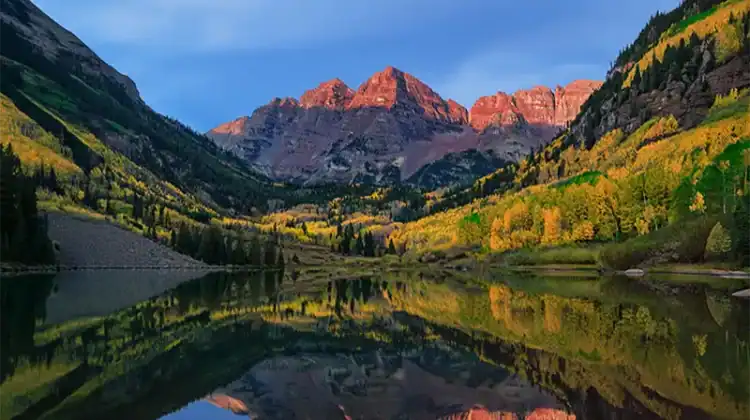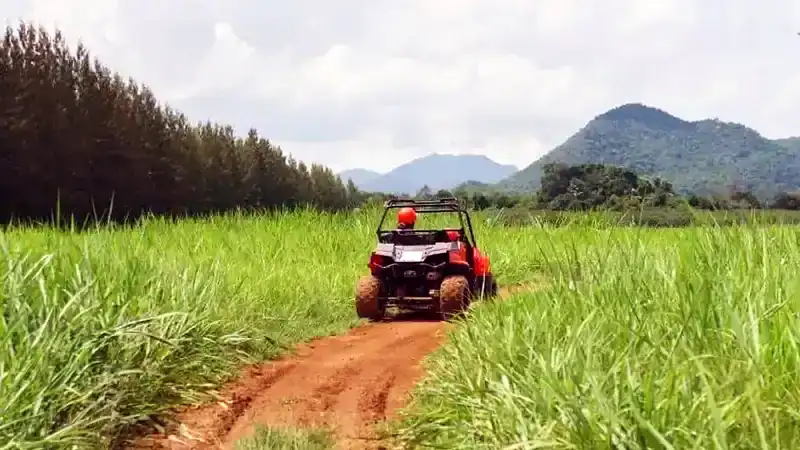
Thank you for reading our post, please rate this article at the end.
Reading Time: 8 minutesLast Updated on October 6, 2025 by Paul Clayton
Table of Contents
Summit the Maroon Bells-Colorados Iconic Twin Peaks
Key Takeaways
-
- Iconic Status and Geology: The Maroon Bells are Colorado’s most photographed twin peaks near Aspen, renowned for their unique maroon color (resulting from the iron mineral hematite) and pristine, glacier-formed Maroon Lake.
- Timing is Key: The optimal time for a visit is summer or fall, when the surrounding Aspen groves turn golden; however, due to high visitor volume, access is restricted during peak seasons, and planning for limited parking or bus transportation is essential.
- Difficulty and Elevation: The primary summit trail is significantly challenging, covering a round-trip distance of miles with an elevation gain of feet, requiring preparedness and experience for hikers attempting the full ascent.
- Critical Safety Awareness: Hikers must be highly aware of altitude sickness (which requires immediate hydration and rest) and the region’s unpredictable weather, which demands carrying layers and a waterproof shell at all times.
Join us as we embark on an unforgettable journey to Summit the Maroon Bells, Colorado’s Iconic Twin Peaks. Renowned for their awe-inspiring beauty, the Maroon Bells are among the most photographed peaks in North America.
The Maroon Bells are perhaps the most iconic peaks in Colorado. Located in the Elk Mountains near Aspen, these twin summits are beloved by hikers and photographers alike.
The Maroon Bells offer a challenging but rewarding hike with stunning views of the surrounding mountains and valleys. If you’re up for a challenge, summiting the Maroon Bells is a must-do Colorado adventure.
The Maroon Valley mountains and lakes were formed over 300 million years of geological activity, including sedimentation, uplift, and erosion caused by wind, water, and ice.
The U.S. Forest Service believes the mountains got their maroon color from the weathering of hematite, an iron mineral. Similarly, Maroon Lake was formed in a basin created by Ice Age glaciers.
I am getting back to conquering the Maroon Bells. Here’s everything you need to know about trekking to the top of the Maroon Bells.
When To Go

The best time to hike the Maroon Bells is in the summer or fall when the weather is mild and there is less snow. However, the Maroon Bells can be hiked year-round, conditions permitting.
If you plan a winter hike, check the weather forecast and avalanche conditions before heading out.
How to get there
The Maroon Bells are located in the White River National Forest, about 10 miles from Aspen. The easiest way to get there is by car; alternatively, you can take a bus from Aspen or Snowmass Village.
There is a large parking area at the Maroon Bells trailhead, but it often fills up early in the day during peak season. If you can’t find a spot, you may park further down the road and walk to the trailhead.
The area around the natural landmark is restricted during the summer and fall due to the high volume of visitors it receives during those times.
Autumn, in particular, is beautiful, with the Maroon Bells surrounded by clouds and blue skies dotted with Aspen groves that have turned golden.
You may also want to consider booking your Aspen airport transportation in advance to avoid worrying about parking at the trailhead.
The Hike

The Maroon Bells hike is about 7 miles round trip, with an elevation gain of about 3,000 feet. The trail is well-marked and relatively easy to follow.
However, it is steep in places and challenging for inexperienced hikers. Some of the most appreciated hikes are:
1. Maroon Lake Scenic Trail
This short and scenic 1-mile hike starts at the parking area and loops around the lake; it’s also worth watching for the beaver pond on your walk.
2. Maroon Creek Trail
Beginning at Maroon Lake, this 3.2-mile one-way trail is excellent for spotting wildlife, including mule deer, red fox, bighorn sheep, porcupines, and various birds, as you travel through alpine meadows, aspen forests, and rocky slopes.
3. Crater Lake Trail
With a challenging yet rewarding 3.6-mile round-trip, this hike is ideal for hikers seeking to explore the beautiful Aspen woodlands and Crater Lake.
Be sure to start at the Deadly Bells Kiosk from the Maroon Lake Trail, and come prepared for a rocky ascent with cooler temperatures, including the possibility of thunderstorms.
Allow yourself plenty of time to complete the hike, and take breaks as needed. The views from the top are well worth the effort!
4. Maroon Bells Camping
If you’re looking for breathtaking views of aspen groves, wildflower meadows, spruce, and fir forests, look no further than Silver Bell Campground.
Situated on the banks of Maroon Creek at 8,460 feet in the White River National Forest, this campground offers 14 tent sites and easy access to excellent trout fishing in Maroon Creek.
Visiting in the Winter

You can’t drive to Maroon Creek Road in the cold months, but you can cross-country ski, snowshoe, or snowmobile there.
T-Lazy-7 Ranch offers visitors a breathtaking snowmobiling tour of the area, featuring sights such as the stunning Maroon Bells set against wintery meadows and aspen groves.
Anchored by a reflective lake and two giant snow-striped mountaintops, Maroon Peak and North Maroon Peak, is a blissful panorama that changes colors with the seasons.
What To Bring
Pack plenty of water, snacks, and a first-aid kit. Hiking boots or shoes with good traction, as well as layers of clothing that can be added or removed as needed, are also essential.
In the summer, sunscreen and insect repellent are essential for protection. Bring warm clothing, gloves, a hat, and traction devices for your shoes or boots in winter.
A camera is also a good idea to capture the incredible views from the top of the Maroon Bells.
Tips for a successful hike
Start early; this will help you avoid the crowds and the day’s heat.
Grab the Right Gear
While having a lot of gear for hiking is unnecessary, some equipment can make your hikes more enjoyable. If you plan to make hiking a regular activity, consider the following items that can enhance your experience. CamelBak is lighter than most other hydration brands, and its design motivates users to drink more water throughout the day.
Hiking Shirt and Pants

When you’re at an REI or Columbia, the salespeople will attempt to sell you hiking clothes. The practical side of your brain is probably telling you not to listen.
But don’t worry, hiking gear is designed to be breathable and withstand different weather conditions (to some degree).
This clothing insulates against cold temperatures and allows sweat and rain to dry quickly. Buy your hiking shoes after getting fitted at a store like REI.
You’ll want to feel comfortable in these shoes, as you’ll be wearing them for hours, so try them on before making a purchase.
Hiking socks are vital to a comfortable hike. Wear one pair while the other dries out.
The night and morning before your hike, be sure to eat well. A dinner rich in protein and carbohydrates will provide the energy you need for the next day. Make sure to have something filling to band on an empty stomach for breakfast.
You’ll use a lot more energy than usual walking uphill, so it’s essential to fuel up beforehand.
Because Colorado’s weather is so unpredictable, wearing layers when hiking is essential. The temperature can drop significantly as you climb higher into the mountains, so even on a warm day, pack a fleece or light jacket.
It’s never a bad idea to carry a waterproof jacket that doubles as a windbreaker, pants, a beanie, and gloves, especially when hiking at higher altitudes.
Check the Weather
Colorado weather is notoriously changeable, so it’s always best to be prepared for anything. Even if the forecast doesn’t show rain, afternoon thunderstorms are common in summer, so it’s always a good idea to throw a rain jacket in your backpack.
Keep an eye out for storm clouds while you’re hiking, and double-check the weather right before you head out.
That way, if conditions look like they might take a turn for the worse, you can turn around early rather than being caught off guard miles from home.
Appropriate Daypack is Imperative
Hiking backpacks come in all shapes and sizes, but daypacks are the smallest and most versatile of them all. Perfect for short or long hikes, choose a daypack that suits your style and preferences.
An essential for any nature lover, be sure to bring a First Aid Kit on your hike in case of an injury. Before your next hike, consider packing or creating a small first-aid kit to take with you.
Your daypack should have a designated pouch for these supplies, which include items such as moleskin (to prevent blisters), bandages, band-aids of various sizes, tweezers, a gauze roll, antiseptic towelettes, antibiotic cream, a multi-use tool, and ibuprofen.
Never underestimate the sun’s power in Colorado – always bring a hat and sunglasses! Also, don’t forget to pack a daypack with everything else you’ll need.
Be Aware of the Symptoms of Altitude Sickness
Signs of altitude sickness include, but are not limited to, headache, nausea and vomiting, dizziness, fatigue, loss of appetite, and shortness of breath. It’s nothing to be ashamed of if you need to lower your sights or ask for help.
If you’re flying in from a place with a significantly higher altitude, consider bringing some canned oxygen along; it may help alleviate your concerns. If you’re feeling ill, drink more water before taking ibuprofen. Ibuprofen will only mask the problem; consuming water might resolve it.
Bring a flashlight, snacks, a compass, a first-aid kit, and a detailed map on every hike. You never know when you might get lost. Take your time: The Maroon Bells are a challenging hike, so don’t try to rush it.
Enjoy the views and take plenty of breaks.
Be prepared. Pack everything you need, and check the weather forecast before you go. And to make your trip even more pleasurable, don’t forget to book a trustworthy service from a luxury transportation company in advance.
Why are the Maroon Bells so Famous?
The Maroon Bells are notable for their exceptional natural beauty and accessibility. It is famous for its stunning visual appeal and prominence in the Rocky Mountains.
These majestic peaks, nestled just south of Aspen, rise more than 14,000 feet above sea level, cloaked in snow throughout summer. Their distinctive maroon-colored bell shape, mirrored in the pristine Maroon Lake below, is a sight that draws in thousands of visitors each year.
This video has been included to clarify the topic. Credit goes to ViewCation
Final Thoughts
Access Planning: During summer and fall, plan to use the bus service from Aspen or Snowmass, as the small parking area at the trailhead fills very early, making vehicle access restricted.
Trail Options: The area offers various trails, including the easy 1-mile Maroon Lake Scenic Trail and the wildlife-rich Maroon Creek Trail (round-trip mileage).
Mandatory Gear & Fuel: Always start early and carry sufficient water, high-carb snacks, layers of breathable hiking clothes, and a detailed first-aid kit to prevent and treat blisters or minor injuries.
Pre-Hike Preparation: Ensure you eat a high-protein, carbohydrate-rich meal the night before and the morning of the hike to sustain your energy. Also, check the weather forecast immediately before heading out to prepare for common afternoon thunderstorms.
Winter Access: In the cold months, Maroon Creek Road is closed to vehicles, and access is only possible via cross-country skiing, snowshoeing, or snowmobiling.






